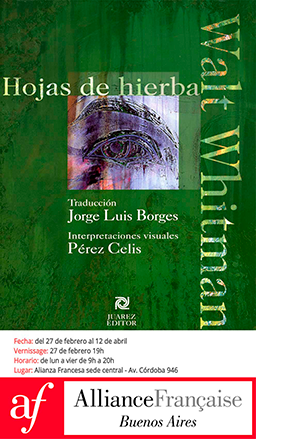EMPTINESS AND COLOR IN LÓPEZ-CHÁVEZ
Under the enlightening title of Los espacios del pánico (Estudios superficiales sobre el vacío y el color) (The spaces of panic-Surface studies on emptiness and color), the interesting individual exhibition that the Madrid gallery El Apartamento dedicates to Luis Enrique Lopez-Chavez (Manzanillo, Cuba, 1988) is developed as a thesis scenario for the almost scientific analysis that the Cuban artist has developed around the space of the void and the chromatic.

Approached from a merely formal way, the exposed result turns the canvas into an apparent geometric or volumetric praxis, where color and perspective have their formal appearance, but which, in reality, also encloses a genesis of personal and locative character. Thus, the emptiness explored by López-Chávez seems to arise from the observation of architecture, of constructions subjected to material precariousness or to the passing of time that impact on them totally alien to those who inhabit them.
Precisely, it is that erratic mark of the building where the volume seems to have a fault that leads to understand the different semiotics around the void, those spaces of panic to which the artist alludes in his exhibition and that can be transformed into niches or areas more doomed to death, a concept on which appears the strength of the chromatic language. Thus, Luis Enrique López-Chávez allows himself the apparent incongruity of the tomb in the living room, of an end in life where geometry and color seem to have abandoned their mitigating task to be mere spectators of the erasure of history, personal or ulterior.
The conceptual aspect of the result also seems to bury any hint of a way out of the impact. The forms established on the canvas, brimming with symmetries, depth and perspectives that forcefully claim a certain formal and aesthetic technicality end up creating a pessimistic, almost aseptic, and impersonal pictorial language, although it never ceases to look at the battles between the aesthetic and the graphic or at that local reality with its own aesthetics that becomes a framework concept for these embodied studies.
Los espacios del pánico (Estudios superficiales sobre el vacío y el color) can be seen until February 8 at the Madrid headquarters of El Apartamento, Puebla, 4, Madrid (Spain).
Related Topics
May interest you
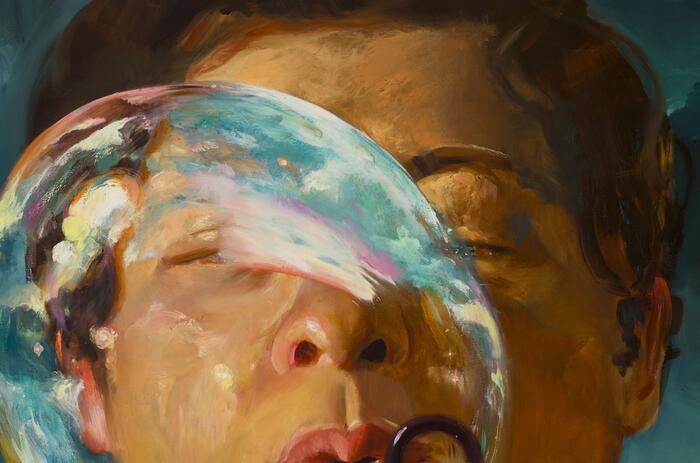
VETA by Fer Francés presents the first solo exhibition of Larry Madrigal (Los Angeles, USA, 1986), one of the latest artists to join the list of those represented by the Madrid gallery. Too Good to be True presents about twenty portraits that revolve around the background of human relationships, interpersonal connection and intimacy, themes that the Mexican-American artist is considering after becoming a father and radically changing his interest in political art.

VETA by Fer Francés presents the first solo exhibition of Larry Madrigal (Los Angeles, USA, 1986), one of the latest artists to join the list of those represented by the Madrid gallery. Too Good to be True presents about twenty portraits that revolve around the background of human relationships, interpersonal connection and intimacy, themes that the Mexican-American artist is considering after becoming a father and radically changing his interest in political art.
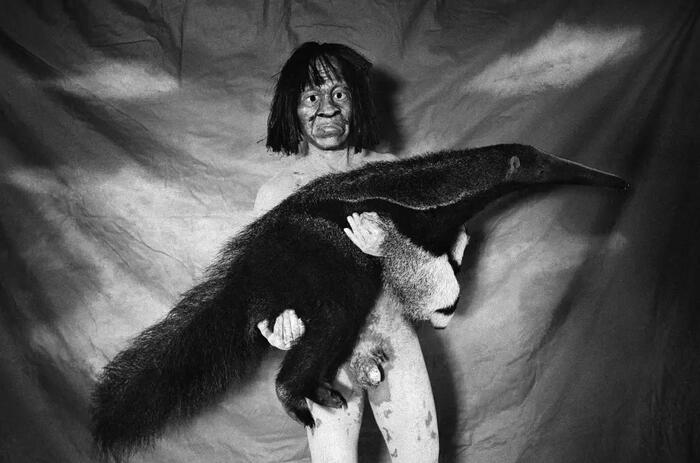
In its exhibition Páro Ques̈há, the Madrid-based MEMORIA presents a dialogue between Roldán Pinedo (Yarinacocha, Peru, 1971) and Javier Silva Meinel (Lima, Peru, 1949), works by both artists that present elements from the heart of the Peruvian Amazon and the Shipibo-Conibo cosmogony. In the imaginary of this Amazonian culture, the drawings receive spirit and life when they are embodied and connected to a further cosmic language. Thus, paintings, ceramics, textiles or instruments of various kinds are considered sacred and become receptacles of spirits whose task is to watch over those who possess them.
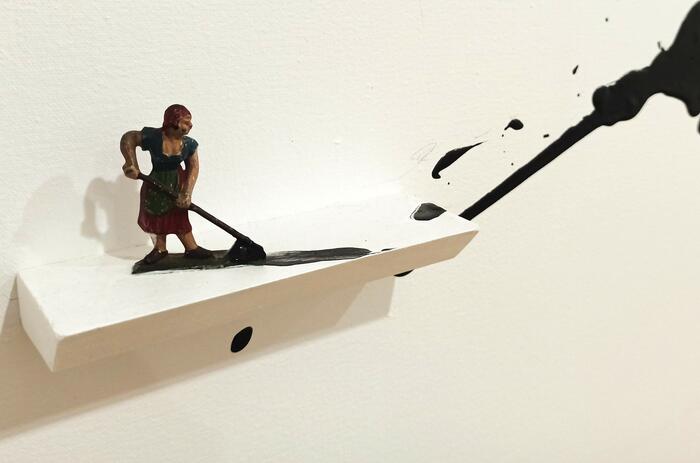
Museo Casa de la Moneda, in Madrid, celebrates in an exhibition the career of Liliana Porter (Buenos Aires, Argentina, 1941) through several conceptual key points of it, designing a necessary route to cover, in a succinct but very representative way, one of the most relevant productions of the last decades of conceptual art.
A COMPLETE OVERVIEW AT LILIANA PORTER
Museo Casa de la Moneda, in Madrid, celebrates in an exhibition the career of Liliana Porter (Buenos Aires, Argentina, 1941) through several conceptual key points of it, designing a necessary route to cover, in a succinct but very representative way, one of the most relevant productions of the last decades of conceptual art.
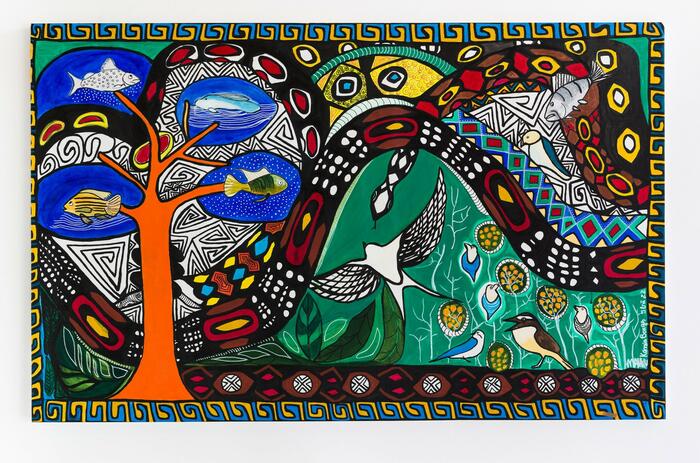
The CCCB (Center of Contemporary Culture of Barcelona) dedicates a wide, meticulous and interesting exhibition that takes us into the natural and cultural heritage of the Amazon, with special emphasis on the art and thought of the cities and indigenous communities of the region. Amazonia. The Ancestral Future brings to the table a detailed vision of artistic practices and Amazonian culture through the work of an extensive list of artists who produce around their thinking and relationship with nature.
A COMPLETE VISION TO THE CULTURAL AMAZON AT CCCB
The CCCB (Center of Contemporary Culture of Barcelona) dedicates a wide, meticulous and interesting exhibition that takes us into the natural and cultural heritage of the Amazon, with special emphasis on the art and thought of the cities and indigenous communities of the region. Amazonia. The Ancestral Future brings to the table a detailed vision of artistic practices and Amazonian culture through the work of an extensive list of artists who produce around their thinking and relationship with nature.
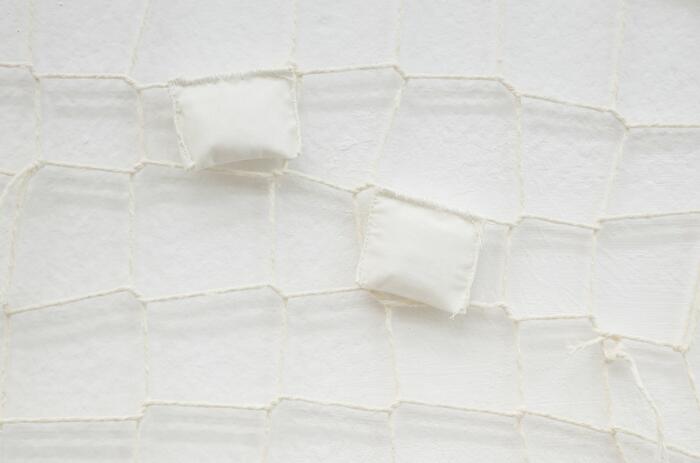
The Spanish gallery presents a group exhibition exploring the act of weaving as a practice that connects stories, heritages, and generations. Soltaré cien conejos y usted verá cómo le hace para juntarlos todos (I will release a hundred rabbits and you will see how you manage to collect them all) reflects on the intersections between the artisanal and the contemporary, addressing themes such as cultural identity, territorial dispossession, and collective memory.

Gabriel O'Shea (Metepec, Mexico, 1998) manages to delve into that huge and apparent dichotomy between the technological and the human (or the future and the real) in his most recent proposal at Hilario Galguera's Madrid headquarters, a series of paintings of high conceptual content that critically debate on several technical and thinking aspects.
GABRIEL O'SHEA'S HUMAN AND REALISTIC TECHNOLOGICAL FUTURE
Gabriel O'Shea (Metepec, Mexico, 1998) manages to delve into that huge and apparent dichotomy between the technological and the human (or the future and the real) in his most recent proposal at Hilario Galguera's Madrid headquarters, a series of paintings of high conceptual content that critically debate on several technical and thinking aspects.

Visión y presencia, the cycle of performances by women artists organized by the Thyssen-Bornemisza Museum, reaches its fourth edition with a renewed program where, once again, the Latin American presence will play a very prominent role. As in previous editions, ten will be the creative proposals that will be staged in different spaces of the Madrid museum and that will be linked to the concept of their proposals, notably revolving around feminism, traditions, colonialism, immigration or ecology.
Visión y presencia, the cycle of performances by women artists organized by the Thyssen-Bornemisza Museum, reaches its fourth edition with a renewed program where, once again, the Latin American presence will play a very prominent role. As in previous editions, ten will be the creative proposals that will be staged in different spaces of the Madrid museum and that will be linked to the concept of their proposals, notably revolving around feminism, traditions, colonialism, immigration or ecology.
Canary Islands-based Mexican Gloria Godinez (Mexico City, Mexico, 1979) will be in charge of opening the cycle with Rojo descolonial en la pintura de Vincent van Gogh (Decolonial red in Vincent van Gogh's painting). The cycle will have a performative action every month, successively (except for July and August), and performances by Elisa Miralles, Yola Balanga, Cuba's Susana Pilar, Costa Rica's Eugenia S. Rudin, Paraguay's Eugenia Rudin and Elisa Miralles are scheduled. Rudin, Paraguay's Jessica Diaz, Chile's Laura Santander, Teresa Correa, Uruguay's Valentina Cardellino and Andrea Ghuisolfi, and O.R.G.I.A. along with three lectures by Brazilian curator Renata Ribeiro, Alma Cardoso and Diana Cuellar.
The Spanish Agency of International Cooperation for Development (AECID) has collaborated in the preparation of the program, as well as the Spanish Cultural Centers in Montevideo, Paraguay and Costa Rica and, for the first time, the Atlantic Center of Modern Art-CAAM of Gran Canaria.
Visión y presencia will be held from January 22 to December 10, 2025 at the Thyssen-Bornemisza Museum, Paseo del Prado, 8, Madrid (Spain).
RENEWED LATIN AMERICAN PRESENCE IN THE THYSSEN PERFORMANCE SERIES “VISIÓN Y PRESENCIA 2025”
Visión y presencia, the cycle of performances by women artists organized by the Thyssen-Bornemisza Museum, reaches its fourth edition with a renewed program where, once again, the Latin American presence will play a very prominent role. As in previous editions, ten will be the creative proposals that will be staged in different spaces of the Madrid museum and that will be linked to the concept of their proposals, notably revolving around feminism, traditions, colonialism, immigration or ecology.
Visión y presencia, the cycle of performances by women artists organized by the Thyssen-Bornemisza Museum, reaches its fourth edition with a renewed program where, once again, the Latin American presence will play a very prominent role. As in previous editions, ten will be the creative proposals that will be staged in different spaces of the Madrid museum and that will be linked to the concept of their proposals, notably revolving around feminism, traditions, colonialism, immigration or ecology.
Canary Islands-based Mexican Gloria Godinez (Mexico City, Mexico, 1979) will be in charge of opening the cycle with Rojo descolonial en la pintura de Vincent van Gogh (Decolonial red in Vincent van Gogh's painting). The cycle will have a performative action every month, successively (except for July and August), and performances by Elisa Miralles, Yola Balanga, Cuba's Susana Pilar, Costa Rica's Eugenia S. Rudin, Paraguay's Eugenia Rudin and Elisa Miralles are scheduled. Rudin, Paraguay's Jessica Diaz, Chile's Laura Santander, Teresa Correa, Uruguay's Valentina Cardellino and Andrea Ghuisolfi, and O.R.G.I.A. along with three lectures by Brazilian curator Renata Ribeiro, Alma Cardoso and Diana Cuellar.
The Spanish Agency of International Cooperation for Development (AECID) has collaborated in the preparation of the program, as well as the Spanish Cultural Centers in Montevideo, Paraguay and Costa Rica and, for the first time, the Atlantic Center of Modern Art-CAAM of Gran Canaria.
Visión y presencia will be held from January 22 to December 10, 2025 at the Thyssen-Bornemisza Museum, Paseo del Prado, 8, Madrid (Spain).
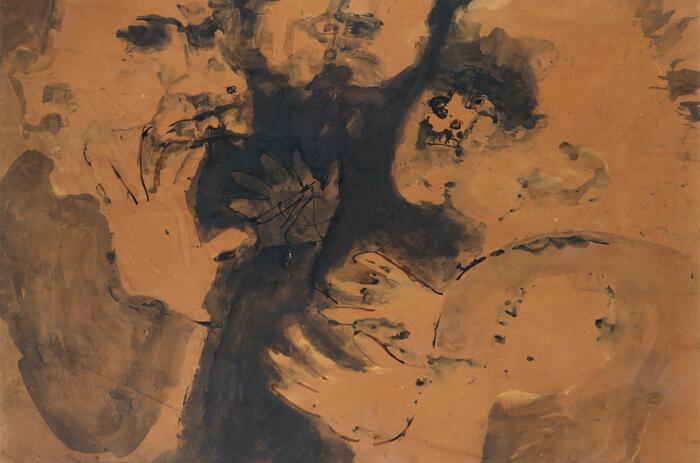
The American Museum of the Cuban Diaspora presents Antonia Eiriz: In the Eye of the Sibyl, an exhibition showcasing the best of the painter’s work from 1960 to 1990, offering an exceptional insight into the creative journey of one of the most controversial and innovative artists in Cuban art of her time.
A COMPREHENSIVE LOOK AT THE LEGACY OF ANTONIA EIRIZ
The American Museum of the Cuban Diaspora presents Antonia Eiriz: In the Eye of the Sibyl, an exhibition showcasing the best of the painter’s work from 1960 to 1990, offering an exceptional insight into the creative journey of one of the most controversial and innovative artists in Cuban art of her time.

VETA by Fer Francés presents the first solo exhibition of Larry Madrigal (Los Angeles, USA, 1986), one of the latest artists to join the list of those represented by the Madrid gallery. Too Good to be True presents about twenty portraits that revolve around the background of human relationships, interpersonal connection and intimacy, themes that the Mexican-American artist is considering after becoming a father and radically changing his interest in political art.

In its exhibition Páro Ques̈há, the Madrid-based MEMORIA presents a dialogue between Roldán Pinedo (Yarinacocha, Peru, 1971) and Javier Silva Meinel (Lima, Peru, 1949), works by both artists that present elements from the heart of the Peruvian Amazon and the Shipibo-Conibo cosmogony. In the imaginary of this Amazonian culture, the drawings receive spirit and life when they are embodied and connected to a further cosmic language. Thus, paintings, ceramics, textiles or instruments of various kinds are considered sacred and become receptacles of spirits whose task is to watch over those who possess them.

Museo Casa de la Moneda, in Madrid, celebrates in an exhibition the career of Liliana Porter (Buenos Aires, Argentina, 1941) through several conceptual key points of it, designing a necessary route to cover, in a succinct but very representative way, one of the most relevant productions of the last decades of conceptual art.
A COMPLETE OVERVIEW AT LILIANA PORTER
Museo Casa de la Moneda, in Madrid, celebrates in an exhibition the career of Liliana Porter (Buenos Aires, Argentina, 1941) through several conceptual key points of it, designing a necessary route to cover, in a succinct but very representative way, one of the most relevant productions of the last decades of conceptual art.

The CCCB (Center of Contemporary Culture of Barcelona) dedicates a wide, meticulous and interesting exhibition that takes us into the natural and cultural heritage of the Amazon, with special emphasis on the art and thought of the cities and indigenous communities of the region. Amazonia. The Ancestral Future brings to the table a detailed vision of artistic practices and Amazonian culture through the work of an extensive list of artists who produce around their thinking and relationship with nature.
A COMPLETE VISION TO THE CULTURAL AMAZON AT CCCB
The CCCB (Center of Contemporary Culture of Barcelona) dedicates a wide, meticulous and interesting exhibition that takes us into the natural and cultural heritage of the Amazon, with special emphasis on the art and thought of the cities and indigenous communities of the region. Amazonia. The Ancestral Future brings to the table a detailed vision of artistic practices and Amazonian culture through the work of an extensive list of artists who produce around their thinking and relationship with nature.

The Spanish gallery presents a group exhibition exploring the act of weaving as a practice that connects stories, heritages, and generations. Soltaré cien conejos y usted verá cómo le hace para juntarlos todos (I will release a hundred rabbits and you will see how you manage to collect them all) reflects on the intersections between the artisanal and the contemporary, addressing themes such as cultural identity, territorial dispossession, and collective memory.

Gabriel O'Shea (Metepec, Mexico, 1998) manages to delve into that huge and apparent dichotomy between the technological and the human (or the future and the real) in his most recent proposal at Hilario Galguera's Madrid headquarters, a series of paintings of high conceptual content that critically debate on several technical and thinking aspects.
GABRIEL O'SHEA'S HUMAN AND REALISTIC TECHNOLOGICAL FUTURE
Gabriel O'Shea (Metepec, Mexico, 1998) manages to delve into that huge and apparent dichotomy between the technological and the human (or the future and the real) in his most recent proposal at Hilario Galguera's Madrid headquarters, a series of paintings of high conceptual content that critically debate on several technical and thinking aspects.

Visión y presencia, the cycle of performances by women artists organized by the Thyssen-Bornemisza Museum, reaches its fourth edition with a renewed program where, once again, the Latin American presence will play a very prominent role. As in previous editions, ten will be the creative proposals that will be staged in different spaces of the Madrid museum and that will be linked to the concept of their proposals, notably revolving around feminism, traditions, colonialism, immigration or ecology.
Visión y presencia, the cycle of performances by women artists organized by the Thyssen-Bornemisza Museum, reaches its fourth edition with a renewed program where, once again, the Latin American presence will play a very prominent role. As in previous editions, ten will be the creative proposals that will be staged in different spaces of the Madrid museum and that will be linked to the concept of their proposals, notably revolving around feminism, traditions, colonialism, immigration or ecology.
Canary Islands-based Mexican Gloria Godinez (Mexico City, Mexico, 1979) will be in charge of opening the cycle with Rojo descolonial en la pintura de Vincent van Gogh (Decolonial red in Vincent van Gogh's painting). The cycle will have a performative action every month, successively (except for July and August), and performances by Elisa Miralles, Yola Balanga, Cuba's Susana Pilar, Costa Rica's Eugenia S. Rudin, Paraguay's Eugenia Rudin and Elisa Miralles are scheduled. Rudin, Paraguay's Jessica Diaz, Chile's Laura Santander, Teresa Correa, Uruguay's Valentina Cardellino and Andrea Ghuisolfi, and O.R.G.I.A. along with three lectures by Brazilian curator Renata Ribeiro, Alma Cardoso and Diana Cuellar.
The Spanish Agency of International Cooperation for Development (AECID) has collaborated in the preparation of the program, as well as the Spanish Cultural Centers in Montevideo, Paraguay and Costa Rica and, for the first time, the Atlantic Center of Modern Art-CAAM of Gran Canaria.
Visión y presencia will be held from January 22 to December 10, 2025 at the Thyssen-Bornemisza Museum, Paseo del Prado, 8, Madrid (Spain).
RENEWED LATIN AMERICAN PRESENCE IN THE THYSSEN PERFORMANCE SERIES “VISIÓN Y PRESENCIA 2025”
Visión y presencia, the cycle of performances by women artists organized by the Thyssen-Bornemisza Museum, reaches its fourth edition with a renewed program where, once again, the Latin American presence will play a very prominent role. As in previous editions, ten will be the creative proposals that will be staged in different spaces of the Madrid museum and that will be linked to the concept of their proposals, notably revolving around feminism, traditions, colonialism, immigration or ecology.
Visión y presencia, the cycle of performances by women artists organized by the Thyssen-Bornemisza Museum, reaches its fourth edition with a renewed program where, once again, the Latin American presence will play a very prominent role. As in previous editions, ten will be the creative proposals that will be staged in different spaces of the Madrid museum and that will be linked to the concept of their proposals, notably revolving around feminism, traditions, colonialism, immigration or ecology.
Canary Islands-based Mexican Gloria Godinez (Mexico City, Mexico, 1979) will be in charge of opening the cycle with Rojo descolonial en la pintura de Vincent van Gogh (Decolonial red in Vincent van Gogh's painting). The cycle will have a performative action every month, successively (except for July and August), and performances by Elisa Miralles, Yola Balanga, Cuba's Susana Pilar, Costa Rica's Eugenia S. Rudin, Paraguay's Eugenia Rudin and Elisa Miralles are scheduled. Rudin, Paraguay's Jessica Diaz, Chile's Laura Santander, Teresa Correa, Uruguay's Valentina Cardellino and Andrea Ghuisolfi, and O.R.G.I.A. along with three lectures by Brazilian curator Renata Ribeiro, Alma Cardoso and Diana Cuellar.
The Spanish Agency of International Cooperation for Development (AECID) has collaborated in the preparation of the program, as well as the Spanish Cultural Centers in Montevideo, Paraguay and Costa Rica and, for the first time, the Atlantic Center of Modern Art-CAAM of Gran Canaria.
Visión y presencia will be held from January 22 to December 10, 2025 at the Thyssen-Bornemisza Museum, Paseo del Prado, 8, Madrid (Spain).

The American Museum of the Cuban Diaspora presents Antonia Eiriz: In the Eye of the Sibyl, an exhibition showcasing the best of the painter’s work from 1960 to 1990, offering an exceptional insight into the creative journey of one of the most controversial and innovative artists in Cuban art of her time.
A COMPREHENSIVE LOOK AT THE LEGACY OF ANTONIA EIRIZ
The American Museum of the Cuban Diaspora presents Antonia Eiriz: In the Eye of the Sibyl, an exhibition showcasing the best of the painter’s work from 1960 to 1990, offering an exceptional insight into the creative journey of one of the most controversial and innovative artists in Cuban art of her time.

VETA by Fer Francés presents the first solo exhibition of Larry Madrigal (Los Angeles, USA, 1986), one of the latest artists to join the list of those represented by the Madrid gallery. Too Good to be True presents about twenty portraits that revolve around the background of human relationships, interpersonal connection and intimacy, themes that the Mexican-American artist is considering after becoming a father and radically changing his interest in political art.

In its exhibition Páro Ques̈há, the Madrid-based MEMORIA presents a dialogue between Roldán Pinedo (Yarinacocha, Peru, 1971) and Javier Silva Meinel (Lima, Peru, 1949), works by both artists that present elements from the heart of the Peruvian Amazon and the Shipibo-Conibo cosmogony. In the imaginary of this Amazonian culture, the drawings receive spirit and life when they are embodied and connected to a further cosmic language. Thus, paintings, ceramics, textiles or instruments of various kinds are considered sacred and become receptacles of spirits whose task is to watch over those who possess them.

Museo Casa de la Moneda, in Madrid, celebrates in an exhibition the career of Liliana Porter (Buenos Aires, Argentina, 1941) through several conceptual key points of it, designing a necessary route to cover, in a succinct but very representative way, one of the most relevant productions of the last decades of conceptual art.
A COMPLETE OVERVIEW AT LILIANA PORTER
Museo Casa de la Moneda, in Madrid, celebrates in an exhibition the career of Liliana Porter (Buenos Aires, Argentina, 1941) through several conceptual key points of it, designing a necessary route to cover, in a succinct but very representative way, one of the most relevant productions of the last decades of conceptual art.

The CCCB (Center of Contemporary Culture of Barcelona) dedicates a wide, meticulous and interesting exhibition that takes us into the natural and cultural heritage of the Amazon, with special emphasis on the art and thought of the cities and indigenous communities of the region. Amazonia. The Ancestral Future brings to the table a detailed vision of artistic practices and Amazonian culture through the work of an extensive list of artists who produce around their thinking and relationship with nature.
A COMPLETE VISION TO THE CULTURAL AMAZON AT CCCB
The CCCB (Center of Contemporary Culture of Barcelona) dedicates a wide, meticulous and interesting exhibition that takes us into the natural and cultural heritage of the Amazon, with special emphasis on the art and thought of the cities and indigenous communities of the region. Amazonia. The Ancestral Future brings to the table a detailed vision of artistic practices and Amazonian culture through the work of an extensive list of artists who produce around their thinking and relationship with nature.

The Spanish gallery presents a group exhibition exploring the act of weaving as a practice that connects stories, heritages, and generations. Soltaré cien conejos y usted verá cómo le hace para juntarlos todos (I will release a hundred rabbits and you will see how you manage to collect them all) reflects on the intersections between the artisanal and the contemporary, addressing themes such as cultural identity, territorial dispossession, and collective memory.

Gabriel O'Shea (Metepec, Mexico, 1998) manages to delve into that huge and apparent dichotomy between the technological and the human (or the future and the real) in his most recent proposal at Hilario Galguera's Madrid headquarters, a series of paintings of high conceptual content that critically debate on several technical and thinking aspects.
GABRIEL O'SHEA'S HUMAN AND REALISTIC TECHNOLOGICAL FUTURE
Gabriel O'Shea (Metepec, Mexico, 1998) manages to delve into that huge and apparent dichotomy between the technological and the human (or the future and the real) in his most recent proposal at Hilario Galguera's Madrid headquarters, a series of paintings of high conceptual content that critically debate on several technical and thinking aspects.

Visión y presencia, the cycle of performances by women artists organized by the Thyssen-Bornemisza Museum, reaches its fourth edition with a renewed program where, once again, the Latin American presence will play a very prominent role. As in previous editions, ten will be the creative proposals that will be staged in different spaces of the Madrid museum and that will be linked to the concept of their proposals, notably revolving around feminism, traditions, colonialism, immigration or ecology.
Visión y presencia, the cycle of performances by women artists organized by the Thyssen-Bornemisza Museum, reaches its fourth edition with a renewed program where, once again, the Latin American presence will play a very prominent role. As in previous editions, ten will be the creative proposals that will be staged in different spaces of the Madrid museum and that will be linked to the concept of their proposals, notably revolving around feminism, traditions, colonialism, immigration or ecology.
Canary Islands-based Mexican Gloria Godinez (Mexico City, Mexico, 1979) will be in charge of opening the cycle with Rojo descolonial en la pintura de Vincent van Gogh (Decolonial red in Vincent van Gogh's painting). The cycle will have a performative action every month, successively (except for July and August), and performances by Elisa Miralles, Yola Balanga, Cuba's Susana Pilar, Costa Rica's Eugenia S. Rudin, Paraguay's Eugenia Rudin and Elisa Miralles are scheduled. Rudin, Paraguay's Jessica Diaz, Chile's Laura Santander, Teresa Correa, Uruguay's Valentina Cardellino and Andrea Ghuisolfi, and O.R.G.I.A. along with three lectures by Brazilian curator Renata Ribeiro, Alma Cardoso and Diana Cuellar.
The Spanish Agency of International Cooperation for Development (AECID) has collaborated in the preparation of the program, as well as the Spanish Cultural Centers in Montevideo, Paraguay and Costa Rica and, for the first time, the Atlantic Center of Modern Art-CAAM of Gran Canaria.
Visión y presencia will be held from January 22 to December 10, 2025 at the Thyssen-Bornemisza Museum, Paseo del Prado, 8, Madrid (Spain).
RENEWED LATIN AMERICAN PRESENCE IN THE THYSSEN PERFORMANCE SERIES “VISIÓN Y PRESENCIA 2025”
Visión y presencia, the cycle of performances by women artists organized by the Thyssen-Bornemisza Museum, reaches its fourth edition with a renewed program where, once again, the Latin American presence will play a very prominent role. As in previous editions, ten will be the creative proposals that will be staged in different spaces of the Madrid museum and that will be linked to the concept of their proposals, notably revolving around feminism, traditions, colonialism, immigration or ecology.
Visión y presencia, the cycle of performances by women artists organized by the Thyssen-Bornemisza Museum, reaches its fourth edition with a renewed program where, once again, the Latin American presence will play a very prominent role. As in previous editions, ten will be the creative proposals that will be staged in different spaces of the Madrid museum and that will be linked to the concept of their proposals, notably revolving around feminism, traditions, colonialism, immigration or ecology.
Canary Islands-based Mexican Gloria Godinez (Mexico City, Mexico, 1979) will be in charge of opening the cycle with Rojo descolonial en la pintura de Vincent van Gogh (Decolonial red in Vincent van Gogh's painting). The cycle will have a performative action every month, successively (except for July and August), and performances by Elisa Miralles, Yola Balanga, Cuba's Susana Pilar, Costa Rica's Eugenia S. Rudin, Paraguay's Eugenia Rudin and Elisa Miralles are scheduled. Rudin, Paraguay's Jessica Diaz, Chile's Laura Santander, Teresa Correa, Uruguay's Valentina Cardellino and Andrea Ghuisolfi, and O.R.G.I.A. along with three lectures by Brazilian curator Renata Ribeiro, Alma Cardoso and Diana Cuellar.
The Spanish Agency of International Cooperation for Development (AECID) has collaborated in the preparation of the program, as well as the Spanish Cultural Centers in Montevideo, Paraguay and Costa Rica and, for the first time, the Atlantic Center of Modern Art-CAAM of Gran Canaria.
Visión y presencia will be held from January 22 to December 10, 2025 at the Thyssen-Bornemisza Museum, Paseo del Prado, 8, Madrid (Spain).

The American Museum of the Cuban Diaspora presents Antonia Eiriz: In the Eye of the Sibyl, an exhibition showcasing the best of the painter’s work from 1960 to 1990, offering an exceptional insight into the creative journey of one of the most controversial and innovative artists in Cuban art of her time.
A COMPREHENSIVE LOOK AT THE LEGACY OF ANTONIA EIRIZ
The American Museum of the Cuban Diaspora presents Antonia Eiriz: In the Eye of the Sibyl, an exhibition showcasing the best of the painter’s work from 1960 to 1990, offering an exceptional insight into the creative journey of one of the most controversial and innovative artists in Cuban art of her time.

VETA by Fer Francés presents the first solo exhibition of Larry Madrigal (Los Angeles, USA, 1986), one of the latest artists to join the list of those represented by the Madrid gallery. Too Good to be True presents about twenty portraits that revolve around the background of human relationships, interpersonal connection and intimacy, themes that the Mexican-American artist is considering after becoming a father and radically changing his interest in political art.

In its exhibition Páro Ques̈há, the Madrid-based MEMORIA presents a dialogue between Roldán Pinedo (Yarinacocha, Peru, 1971) and Javier Silva Meinel (Lima, Peru, 1949), works by both artists that present elements from the heart of the Peruvian Amazon and the Shipibo-Conibo cosmogony. In the imaginary of this Amazonian culture, the drawings receive spirit and life when they are embodied and connected to a further cosmic language. Thus, paintings, ceramics, textiles or instruments of various kinds are considered sacred and become receptacles of spirits whose task is to watch over those who possess them.

Museo Casa de la Moneda, in Madrid, celebrates in an exhibition the career of Liliana Porter (Buenos Aires, Argentina, 1941) through several conceptual key points of it, designing a necessary route to cover, in a succinct but very representative way, one of the most relevant productions of the last decades of conceptual art.
A COMPLETE OVERVIEW AT LILIANA PORTER
Museo Casa de la Moneda, in Madrid, celebrates in an exhibition the career of Liliana Porter (Buenos Aires, Argentina, 1941) through several conceptual key points of it, designing a necessary route to cover, in a succinct but very representative way, one of the most relevant productions of the last decades of conceptual art.

The CCCB (Center of Contemporary Culture of Barcelona) dedicates a wide, meticulous and interesting exhibition that takes us into the natural and cultural heritage of the Amazon, with special emphasis on the art and thought of the cities and indigenous communities of the region. Amazonia. The Ancestral Future brings to the table a detailed vision of artistic practices and Amazonian culture through the work of an extensive list of artists who produce around their thinking and relationship with nature.
A COMPLETE VISION TO THE CULTURAL AMAZON AT CCCB
The CCCB (Center of Contemporary Culture of Barcelona) dedicates a wide, meticulous and interesting exhibition that takes us into the natural and cultural heritage of the Amazon, with special emphasis on the art and thought of the cities and indigenous communities of the region. Amazonia. The Ancestral Future brings to the table a detailed vision of artistic practices and Amazonian culture through the work of an extensive list of artists who produce around their thinking and relationship with nature.

The Spanish gallery presents a group exhibition exploring the act of weaving as a practice that connects stories, heritages, and generations. Soltaré cien conejos y usted verá cómo le hace para juntarlos todos (I will release a hundred rabbits and you will see how you manage to collect them all) reflects on the intersections between the artisanal and the contemporary, addressing themes such as cultural identity, territorial dispossession, and collective memory.

Gabriel O'Shea (Metepec, Mexico, 1998) manages to delve into that huge and apparent dichotomy between the technological and the human (or the future and the real) in his most recent proposal at Hilario Galguera's Madrid headquarters, a series of paintings of high conceptual content that critically debate on several technical and thinking aspects.
GABRIEL O'SHEA'S HUMAN AND REALISTIC TECHNOLOGICAL FUTURE
Gabriel O'Shea (Metepec, Mexico, 1998) manages to delve into that huge and apparent dichotomy between the technological and the human (or the future and the real) in his most recent proposal at Hilario Galguera's Madrid headquarters, a series of paintings of high conceptual content that critically debate on several technical and thinking aspects.

Visión y presencia, the cycle of performances by women artists organized by the Thyssen-Bornemisza Museum, reaches its fourth edition with a renewed program where, once again, the Latin American presence will play a very prominent role. As in previous editions, ten will be the creative proposals that will be staged in different spaces of the Madrid museum and that will be linked to the concept of their proposals, notably revolving around feminism, traditions, colonialism, immigration or ecology.
Visión y presencia, the cycle of performances by women artists organized by the Thyssen-Bornemisza Museum, reaches its fourth edition with a renewed program where, once again, the Latin American presence will play a very prominent role. As in previous editions, ten will be the creative proposals that will be staged in different spaces of the Madrid museum and that will be linked to the concept of their proposals, notably revolving around feminism, traditions, colonialism, immigration or ecology.
Canary Islands-based Mexican Gloria Godinez (Mexico City, Mexico, 1979) will be in charge of opening the cycle with Rojo descolonial en la pintura de Vincent van Gogh (Decolonial red in Vincent van Gogh's painting). The cycle will have a performative action every month, successively (except for July and August), and performances by Elisa Miralles, Yola Balanga, Cuba's Susana Pilar, Costa Rica's Eugenia S. Rudin, Paraguay's Eugenia Rudin and Elisa Miralles are scheduled. Rudin, Paraguay's Jessica Diaz, Chile's Laura Santander, Teresa Correa, Uruguay's Valentina Cardellino and Andrea Ghuisolfi, and O.R.G.I.A. along with three lectures by Brazilian curator Renata Ribeiro, Alma Cardoso and Diana Cuellar.
The Spanish Agency of International Cooperation for Development (AECID) has collaborated in the preparation of the program, as well as the Spanish Cultural Centers in Montevideo, Paraguay and Costa Rica and, for the first time, the Atlantic Center of Modern Art-CAAM of Gran Canaria.
Visión y presencia will be held from January 22 to December 10, 2025 at the Thyssen-Bornemisza Museum, Paseo del Prado, 8, Madrid (Spain).
RENEWED LATIN AMERICAN PRESENCE IN THE THYSSEN PERFORMANCE SERIES “VISIÓN Y PRESENCIA 2025”
Visión y presencia, the cycle of performances by women artists organized by the Thyssen-Bornemisza Museum, reaches its fourth edition with a renewed program where, once again, the Latin American presence will play a very prominent role. As in previous editions, ten will be the creative proposals that will be staged in different spaces of the Madrid museum and that will be linked to the concept of their proposals, notably revolving around feminism, traditions, colonialism, immigration or ecology.
Visión y presencia, the cycle of performances by women artists organized by the Thyssen-Bornemisza Museum, reaches its fourth edition with a renewed program where, once again, the Latin American presence will play a very prominent role. As in previous editions, ten will be the creative proposals that will be staged in different spaces of the Madrid museum and that will be linked to the concept of their proposals, notably revolving around feminism, traditions, colonialism, immigration or ecology.
Canary Islands-based Mexican Gloria Godinez (Mexico City, Mexico, 1979) will be in charge of opening the cycle with Rojo descolonial en la pintura de Vincent van Gogh (Decolonial red in Vincent van Gogh's painting). The cycle will have a performative action every month, successively (except for July and August), and performances by Elisa Miralles, Yola Balanga, Cuba's Susana Pilar, Costa Rica's Eugenia S. Rudin, Paraguay's Eugenia Rudin and Elisa Miralles are scheduled. Rudin, Paraguay's Jessica Diaz, Chile's Laura Santander, Teresa Correa, Uruguay's Valentina Cardellino and Andrea Ghuisolfi, and O.R.G.I.A. along with three lectures by Brazilian curator Renata Ribeiro, Alma Cardoso and Diana Cuellar.
The Spanish Agency of International Cooperation for Development (AECID) has collaborated in the preparation of the program, as well as the Spanish Cultural Centers in Montevideo, Paraguay and Costa Rica and, for the first time, the Atlantic Center of Modern Art-CAAM of Gran Canaria.
Visión y presencia will be held from January 22 to December 10, 2025 at the Thyssen-Bornemisza Museum, Paseo del Prado, 8, Madrid (Spain).

The American Museum of the Cuban Diaspora presents Antonia Eiriz: In the Eye of the Sibyl, an exhibition showcasing the best of the painter’s work from 1960 to 1990, offering an exceptional insight into the creative journey of one of the most controversial and innovative artists in Cuban art of her time.
A COMPREHENSIVE LOOK AT THE LEGACY OF ANTONIA EIRIZ
The American Museum of the Cuban Diaspora presents Antonia Eiriz: In the Eye of the Sibyl, an exhibition showcasing the best of the painter’s work from 1960 to 1990, offering an exceptional insight into the creative journey of one of the most controversial and innovative artists in Cuban art of her time.

VETA by Fer Francés presents the first solo exhibition of Larry Madrigal (Los Angeles, USA, 1986), one of the latest artists to join the list of those represented by the Madrid gallery. Too Good to be True presents about twenty portraits that revolve around the background of human relationships, interpersonal connection and intimacy, themes that the Mexican-American artist is considering after becoming a father and radically changing his interest in political art.

In its exhibition Páro Ques̈há, the Madrid-based MEMORIA presents a dialogue between Roldán Pinedo (Yarinacocha, Peru, 1971) and Javier Silva Meinel (Lima, Peru, 1949), works by both artists that present elements from the heart of the Peruvian Amazon and the Shipibo-Conibo cosmogony. In the imaginary of this Amazonian culture, the drawings receive spirit and life when they are embodied and connected to a further cosmic language. Thus, paintings, ceramics, textiles or instruments of various kinds are considered sacred and become receptacles of spirits whose task is to watch over those who possess them.

Museo Casa de la Moneda, in Madrid, celebrates in an exhibition the career of Liliana Porter (Buenos Aires, Argentina, 1941) through several conceptual key points of it, designing a necessary route to cover, in a succinct but very representative way, one of the most relevant productions of the last decades of conceptual art.
A COMPLETE OVERVIEW AT LILIANA PORTER
Museo Casa de la Moneda, in Madrid, celebrates in an exhibition the career of Liliana Porter (Buenos Aires, Argentina, 1941) through several conceptual key points of it, designing a necessary route to cover, in a succinct but very representative way, one of the most relevant productions of the last decades of conceptual art.

The CCCB (Center of Contemporary Culture of Barcelona) dedicates a wide, meticulous and interesting exhibition that takes us into the natural and cultural heritage of the Amazon, with special emphasis on the art and thought of the cities and indigenous communities of the region. Amazonia. The Ancestral Future brings to the table a detailed vision of artistic practices and Amazonian culture through the work of an extensive list of artists who produce around their thinking and relationship with nature.
A COMPLETE VISION TO THE CULTURAL AMAZON AT CCCB
The CCCB (Center of Contemporary Culture of Barcelona) dedicates a wide, meticulous and interesting exhibition that takes us into the natural and cultural heritage of the Amazon, with special emphasis on the art and thought of the cities and indigenous communities of the region. Amazonia. The Ancestral Future brings to the table a detailed vision of artistic practices and Amazonian culture through the work of an extensive list of artists who produce around their thinking and relationship with nature.

The Spanish gallery presents a group exhibition exploring the act of weaving as a practice that connects stories, heritages, and generations. Soltaré cien conejos y usted verá cómo le hace para juntarlos todos (I will release a hundred rabbits and you will see how you manage to collect them all) reflects on the intersections between the artisanal and the contemporary, addressing themes such as cultural identity, territorial dispossession, and collective memory.

Gabriel O'Shea (Metepec, Mexico, 1998) manages to delve into that huge and apparent dichotomy between the technological and the human (or the future and the real) in his most recent proposal at Hilario Galguera's Madrid headquarters, a series of paintings of high conceptual content that critically debate on several technical and thinking aspects.
GABRIEL O'SHEA'S HUMAN AND REALISTIC TECHNOLOGICAL FUTURE
Gabriel O'Shea (Metepec, Mexico, 1998) manages to delve into that huge and apparent dichotomy between the technological and the human (or the future and the real) in his most recent proposal at Hilario Galguera's Madrid headquarters, a series of paintings of high conceptual content that critically debate on several technical and thinking aspects.

Visión y presencia, the cycle of performances by women artists organized by the Thyssen-Bornemisza Museum, reaches its fourth edition with a renewed program where, once again, the Latin American presence will play a very prominent role. As in previous editions, ten will be the creative proposals that will be staged in different spaces of the Madrid museum and that will be linked to the concept of their proposals, notably revolving around feminism, traditions, colonialism, immigration or ecology.
Visión y presencia, the cycle of performances by women artists organized by the Thyssen-Bornemisza Museum, reaches its fourth edition with a renewed program where, once again, the Latin American presence will play a very prominent role. As in previous editions, ten will be the creative proposals that will be staged in different spaces of the Madrid museum and that will be linked to the concept of their proposals, notably revolving around feminism, traditions, colonialism, immigration or ecology.
Canary Islands-based Mexican Gloria Godinez (Mexico City, Mexico, 1979) will be in charge of opening the cycle with Rojo descolonial en la pintura de Vincent van Gogh (Decolonial red in Vincent van Gogh's painting). The cycle will have a performative action every month, successively (except for July and August), and performances by Elisa Miralles, Yola Balanga, Cuba's Susana Pilar, Costa Rica's Eugenia S. Rudin, Paraguay's Eugenia Rudin and Elisa Miralles are scheduled. Rudin, Paraguay's Jessica Diaz, Chile's Laura Santander, Teresa Correa, Uruguay's Valentina Cardellino and Andrea Ghuisolfi, and O.R.G.I.A. along with three lectures by Brazilian curator Renata Ribeiro, Alma Cardoso and Diana Cuellar.
The Spanish Agency of International Cooperation for Development (AECID) has collaborated in the preparation of the program, as well as the Spanish Cultural Centers in Montevideo, Paraguay and Costa Rica and, for the first time, the Atlantic Center of Modern Art-CAAM of Gran Canaria.
Visión y presencia will be held from January 22 to December 10, 2025 at the Thyssen-Bornemisza Museum, Paseo del Prado, 8, Madrid (Spain).
RENEWED LATIN AMERICAN PRESENCE IN THE THYSSEN PERFORMANCE SERIES “VISIÓN Y PRESENCIA 2025”
Visión y presencia, the cycle of performances by women artists organized by the Thyssen-Bornemisza Museum, reaches its fourth edition with a renewed program where, once again, the Latin American presence will play a very prominent role. As in previous editions, ten will be the creative proposals that will be staged in different spaces of the Madrid museum and that will be linked to the concept of their proposals, notably revolving around feminism, traditions, colonialism, immigration or ecology.
Visión y presencia, the cycle of performances by women artists organized by the Thyssen-Bornemisza Museum, reaches its fourth edition with a renewed program where, once again, the Latin American presence will play a very prominent role. As in previous editions, ten will be the creative proposals that will be staged in different spaces of the Madrid museum and that will be linked to the concept of their proposals, notably revolving around feminism, traditions, colonialism, immigration or ecology.
Canary Islands-based Mexican Gloria Godinez (Mexico City, Mexico, 1979) will be in charge of opening the cycle with Rojo descolonial en la pintura de Vincent van Gogh (Decolonial red in Vincent van Gogh's painting). The cycle will have a performative action every month, successively (except for July and August), and performances by Elisa Miralles, Yola Balanga, Cuba's Susana Pilar, Costa Rica's Eugenia S. Rudin, Paraguay's Eugenia Rudin and Elisa Miralles are scheduled. Rudin, Paraguay's Jessica Diaz, Chile's Laura Santander, Teresa Correa, Uruguay's Valentina Cardellino and Andrea Ghuisolfi, and O.R.G.I.A. along with three lectures by Brazilian curator Renata Ribeiro, Alma Cardoso and Diana Cuellar.
The Spanish Agency of International Cooperation for Development (AECID) has collaborated in the preparation of the program, as well as the Spanish Cultural Centers in Montevideo, Paraguay and Costa Rica and, for the first time, the Atlantic Center of Modern Art-CAAM of Gran Canaria.
Visión y presencia will be held from January 22 to December 10, 2025 at the Thyssen-Bornemisza Museum, Paseo del Prado, 8, Madrid (Spain).

The American Museum of the Cuban Diaspora presents Antonia Eiriz: In the Eye of the Sibyl, an exhibition showcasing the best of the painter’s work from 1960 to 1990, offering an exceptional insight into the creative journey of one of the most controversial and innovative artists in Cuban art of her time.
A COMPREHENSIVE LOOK AT THE LEGACY OF ANTONIA EIRIZ
The American Museum of the Cuban Diaspora presents Antonia Eiriz: In the Eye of the Sibyl, an exhibition showcasing the best of the painter’s work from 1960 to 1990, offering an exceptional insight into the creative journey of one of the most controversial and innovative artists in Cuban art of her time.

